EnviroReporter.com‘s extensive investigation into radiation experiments on animals and people at UCLA and the West LA VA, as reported on in “Where the Bodies are Buried,” suggests that there may be no need to nuke squirrel monkeys as the results are already well known: intense radiation exposure can disable and kill mammals. Thousands of experiments have already shown this.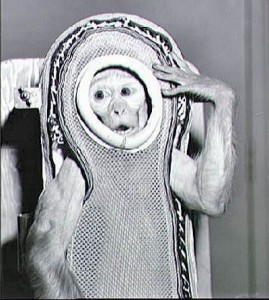
One of the only known ways to protect against this radiation, lead shielding, would be required in spacecraft and astronauts’ suits and would render spacecraft and astronauts too heavy to be practical. Other ideas, like using the spacecraft’s liquid nitrogen fuel to act as a deflector in the hull, haven’t been tested.
Cosmic rays consist of high energy protons and other nuclei so intense that the Apollo astronauts reported seeing flashes in their eyeballs. The 24 astronauts who made up the Apollo program, the only time men ever in deep space, are too small a number statistically to be able to be scientifically representative but it is thought that they have suffered a higher rate of cancer. Plus the longest flight the Apollo astronauts rode on was less than two weeks.
Estimates of radiation exposure in outer space do exist. An unshielded interplanetary astronaut would receive about 400 to 900 milli-Sieverts (mSv) annually, compared to 2.4 mSv on Earth. Even a ‘shielded’ mission to Mars lasting 30 months would irradiate humans with up to 1,000 mSv (1 Sv) which is approaching the lifetime limit, 1 to 4 Sv, advised for so-called “low Earth orbit activities” of astronauts as determined by the National Council on Radiation Protection and Measurements.
No known shielding would be totally effective against both galactic cosmic rays and higher energy waves that wouldn’t weigh hundreds of metric tons. Even that shielding can cause reflective ‘bounce back’ or secondary radiation exposure.
The radiation in outer space is intense, especially during solar proton events when the Sun emits a solar flare or coronal mass ejections.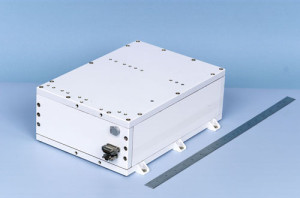
NASA found this out the ‘hot’ way when it launched its 2001 Mars Odyssey on April 7, 2001. The spacecraft was designed to measure radiation on the way to Mars and while in the Martian orbit. On board was a sophisticated device called the Martian Radiation Environment Experiment, or MARIE, which started malfunctioning in late 2003 after a series of particularly strong solar flares blasted the spacecraft.
Marie was toasted with particle radiation. MARIE could not be salvaged demonstrating that even robotic missions in outer space aren’t immune from destructive cosmic radiation. The solar proton event that disabled MARIE was not detected on Earth meaning that the radiation was directional and therefore impossible to predict. This could obviously have a deleterious effect on any manned missions to Mars.
Perhaps the answer is in a reassessment of the actual effects of high energy radiation to find out if it isn’t so hot after all.
Irradiating two dozen squirrel monkeys to test their cognitive responses suggests that NASA knows it won’t be able to adequately shield astronauts living on the Moon and traveling to and from Mars. If the monkeys perform effectively even after being dosed with a massive shot of gamma radiation, the argument could be made that humans could do the same. Monkey see, Man do.
Monkeying Around
Scant media attention has paid to the moral and ethical issues surrounding renewed radiation experimentation on primates, let alone the questionable science behind it. Groups like People for the Ethical Treatment of Animals, or PETA, has tried to change that but the effort has barely made a blip on the media radar so far despite a spat of protests.
A small knot of PETA protesters stood outside the Smithsonian National Air and Space Museum January 14 with signs that read “Stop Radiation Tests On Monkeys” and “Astronauts, Yes, Radiation Monkeys, No!” A similar protest was held two days earlier at NASA Langley Research Center in Long Island, where PETA members dressed as monkeys confined themselves in cages for passersby to see.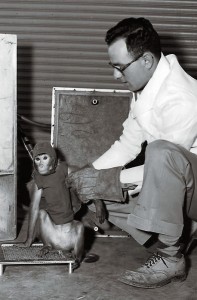
In the study, the monkeys will be shot up with a single substantial dose of gamma radiation, which NASA’s project leader Bergman insists would simulate what a human would receive over the 130 to 260 days it would take to travel to and explore the red planet, depending on rocket velocity, planetary transfer orbits, and the closeness of the planets.
“NASA prides itself on looking to the future, but when it comes to crude and cruel animal experiments, the agency is stuck in the Dark Ages,” said PETA Vice President of Laboratory Investigations Kathy Guillermo in a statement on the group’s website. “Monkeys are highly social, sensitive, and intelligent animals. Harming them in experiments so that NASA can check off another item on its seemingly endless list of questions about outer space is unjustifiable, especially when modern, humane research methods exist.”
The controversy has been picked up by Discovery News and a Scripts News Service wire story appeared in Kansas City.
“We realized there was a need for this kind of work,” project originator Jack Bergman, Ph.D., a behavioral pharmacologist at Harvard Medical School’s McLean Hospital in Boston, told Discovery News reporter Irene Klotz for an October 29, 2009 article entitled “NASA To Start Irradiating Monkeys – Spider monkeys will be exposed to regular, low dose radiation as NASA invesgitates [sic] the effects of long term space travel.”
“There’s a long-standing commitment on the part of NASA to deep space travel and with that commitment comes a need for knowing what kinds of adverse effects deep space travel might have, what are the risks to astronauts,” Bergman continued. “That’s not been well assessed.”
The subheadline of the article is inaccurate in two significant ways: the monkeys won’t be exposed to “regular” radiation, but rather one massive gamma radiation injection, and the radiation is not “low dose” as the dose is supposed to simulate months’ worth of “HVE,” or high energy particles of high atomic number, that people exploring the Moon or traveling to Mars would experience zipping through them.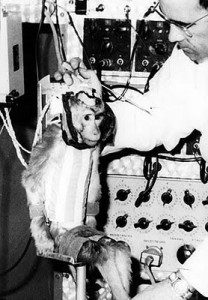
Bergman’s statement that the risks to astronauts have “not been well assessed” is suspect. The risks have been assessed and they are significant. President Bush stated this when he announced the initiative.
Another article for Discovery News penned five months earlier by the same reporter entitled “Space Torso Reveals Cancer Risk for Astronauts” says “The information collected so far confirms that NASA’s current guidelines for assessing radiation risks are pretty much on target, said Francis Cucinotta, a doctor and researcher who heads radiation studies at the Johnson Space Center in Houston.”
So if the risk assessments are “pretty much on target,” why would NASA spend $1.75 million on Bergman’s experiments to nuke two dozen squirrel monkeys? The answer may lie in a passage later in the article:
Cucinotta figures the agency has about five years to come up with some solutions to the radiation problem or find evidence that refutes current assessments of the risks. More shielding on moon and Mars ships probably isn’t the answer, Cucinotta told Discovery News. The additional weight would make the spacecraft too heavy to launch with today’s technologies. (Our emphasis)
That evidence could be obtained by showing that the monkeys essentially shake off the radiation and continue to perform tasks effectively since shielding and gene-repairing pharmaceuticals seem out of the question.
“We’d all be cured of cancer on Earth if we knew how to do this,” Cucinotta told Discovery News of the use of drugs to diminish radiation damage.
This seems to suggest that NASA is hoping that the monkeys will still be able to perform tasks efficiently even though they’ve been radiologically poisoned in order to justify high radiation exposure for future outer space explorers. With the dangers of radiation well known for over a half century, through thousands of tests on plants, animals and humans, why else would NASA nuke the monkeys?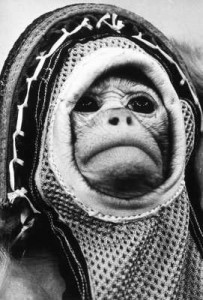
NASA admittedly doesn’t know how to do how to send astronauts safely into outer space for extended periods of time, but zapping monkeys won’t solve NASA’s space travel conundrum. Humans won’t be exposed to outer space radiation through a massive one-time injection and humans aren’t monkeys.
Radiation experiments on animals have already yielded voluminous amounts of data over the decades, nearly all of which came to the same conclusion: radiation can put a whole world of hurt into animals and, by extension, humans. The squirrel monkeys to be tested on are about to find that out themselves.
PETA Push Back
PETA, which claims two million members, has tried to publicize the impending experiments citing the disturbing effects that radiating monkeys can have including the induction of fatal cancers, brain tumors, cataracts, teeth falling out, cognitive decline and self-mutilation.
“In the 1950s, chimpanzees were taken from their natural habitat, kidnapped from their families, and used as crash-test dummies in experiments in which they had their necks broken and their skin burned off and were severely maimed for the purposes of testing missiles, helmets, and windshields,” wrote Justin Goodman, Research Associate Supervisor for PETA’s Laboratory Investigations Department in a November 4, 2009 letter to NASA administrator Charles F. Bolden Jr. “Since then, hundreds—perhaps thousands—of monkeys have been exposed to dangerous levels of radiation, and others, some of whom had their tails chopped off, have been launched into space on ill-fated missions that caused them to suffer from brain damage, heart failure, and other health complications from which they never recovered.”
“In the past, NASA has halted plans to use monkeys in space experiments when the public spoke out against this cruelty, and animals need your support once again,” says PETA’s webpage Stop NASA’s Plans to Expose Monkeys to Radiation where activists can write an e-mail to Bolden to “politely ask him to permanently halt plans to conduct radiation experiments using monkeys and to instead direct their funds to modern and humane methods of scientific inquiry.”












Recent Comments